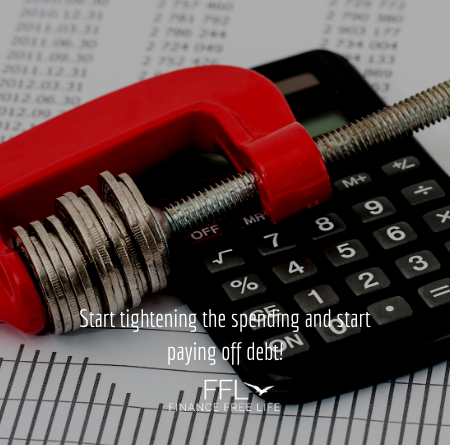4 Things You Should Start Today To Shorten Your Debt Payoff
In the last post, we talked about how to create your debt payoff plan, aligned with a basic debt snowball plan. If you didn’t read it, you can catch up here. Basically, the concept is this: list all your debts, least to greatest, with their minimum payments. Then, create a plan to pay them off as quickly as possible, by applying the minimum payment of the first debt, plus any extra income you have, towards the first loan.
An example and refresher for everyone reading:
- $600 credit card ($60 minimum payment)
- $1,500 credit card ($70 minimum payment)
- $8,000 student loan ($90 minimum payment)
- $10,000 car loan ($120 minimum payment)
The first debt has a $60 minimum payment, plus an additional $240 a month from our budget. That’s a $300 payment towards the credit card, gone in 2 months. $300 from the from the first credit card now gets added to the $70 payment on the second credit card, paid off in 6 months. Next, $370 paid on the 2nd credit card now gets added to the $90 student loan payment. With these additional payments, that student loan is paid off in 18 months. The last payment now has all $460 added to the original $120 towards the car loan and is paid off in 35 months. Congratulations! In 35 months, you’ve paid off $20,100 of debt.
This is pretty good, considering the car loan had at least a 36-month term, and the student loan at least 120 months. Everything got paid off early, you saved money in interest, and you’re officially living the Finance Free Life. However, I think you can pay it off sooner than nearly 3 years if you’re focused and determined to pay it off as quickly as possible. Here are some ways you can do that.
Re-evaluate your budget.
 The first step is to review your budget for any places you can cut back expenses. How intensely do you want to attack your debt? How badly do you want to be debt free?
The first step is to review your budget for any places you can cut back expenses. How intensely do you want to attack your debt? How badly do you want to be debt free?
Story-time: when my husband and I were first venturing down this road, we were broke. I was making a teacher’s salary, and he was working full-time while finishing his degree. We wanted to live on a budget, so we could get out of debt. So, we pared down to as little as possible – no cable, no gym memberships, nothing extras. We ate pasta, peanut butter and jelly, and cereal. The picky eater’s version of rice and beans. Our grocery budget was $100 a month – $50 per paycheck.
You will need to figure out what your necessities are, and cut out the rest. How much could you do if you were debt free? Make the small sacrifices now, for the large returns later.
Level-up your income.
 This might sound obvious, but if you are serious about paying off your debt, consider changing jobs for something that pays more than your current job. You may also consider taking on a second job, to earn more income to pay off your debt faster. Turn that 35 months into 24 months, or 18 months and you’re debt free. What would you do if you were debt free? When you are intensely pursuing becoming debt free, you are willing to make sacrifices now for long-term gains.
This might sound obvious, but if you are serious about paying off your debt, consider changing jobs for something that pays more than your current job. You may also consider taking on a second job, to earn more income to pay off your debt faster. Turn that 35 months into 24 months, or 18 months and you’re debt free. What would you do if you were debt free? When you are intensely pursuing becoming debt free, you are willing to make sacrifices now for long-term gains.
Anything extra – applies to debt!
 What I mean by this one, is that any extra income – bonuses, tax refunds, commissions, etc. – that you receive which is not a part of your regularly budgeted income, should be applied to your debt attack. Take the example above for debt payoff. The same scenario, but in April, you get a tax return of $4,000. Instead of blowing it, you apply it ALL towards debt. In one fell swoop, both credit cards are paid off, and your student loan is down to $5550. By now, you’re paying $460 towards that debt. In December, you get your annual review, a Christmas bonus, and a check from Grandma. You are crazy intense towards paying off debt, so you apply it ALL towards debt again, about $1,200. Now you have about $1,200 towards your student loan, and $8,800 left on your car by maintaining minimum payments. When April rolls around again, you get another tax return of $3500, which can all go towards the car loan. In eight months, the car is paid off, and you are debt free in a total of 22 months.
What I mean by this one, is that any extra income – bonuses, tax refunds, commissions, etc. – that you receive which is not a part of your regularly budgeted income, should be applied to your debt attack. Take the example above for debt payoff. The same scenario, but in April, you get a tax return of $4,000. Instead of blowing it, you apply it ALL towards debt. In one fell swoop, both credit cards are paid off, and your student loan is down to $5550. By now, you’re paying $460 towards that debt. In December, you get your annual review, a Christmas bonus, and a check from Grandma. You are crazy intense towards paying off debt, so you apply it ALL towards debt again, about $1,200. Now you have about $1,200 towards your student loan, and $8,800 left on your car by maintaining minimum payments. When April rolls around again, you get another tax return of $3500, which can all go towards the car loan. In eight months, the car is paid off, and you are debt free in a total of 22 months.
That is 13 months less than the original scenario, just by attacking the debt with all you’ve got. What would you do if you were completely debt free? Attacking your debt means hitting it with everything you’ve got – making the sacrifices now, for a debt free life as fast a possible.
Downsize your life.

Evaluate your overall lifestyle, your possessions, and see if there is anything you can sell for additional income. Possible items you can sell would be anything considered a “toy” – vehicles, ATVs, boats, guns, instruments, motorcycles, etc. Anything that is outside the confines of your income, needs to go. When you are trying to get out of debt, you need to sell anything that does not match your current lifestyle. If you make $60,000, drive a $35,000 car, $5000 in “toy” loans, on top of your other consumer debt, you need to downsize. Any debt you can get rid of by selling it will help you get ahead. How much could you do if you were completely debt free? Throw everything you’ve got at your debt, to pay it off furiously.
There you have it. If you are determined to be debt free, you can pay off your debt at a rapid pace. Most of these strategies, you can start as early as today. Remember, it’s up to you to decide how intensely you want to attack your debt – how badly do you want to be out of debt? Your answer to that question determines your method towards paying it off.

